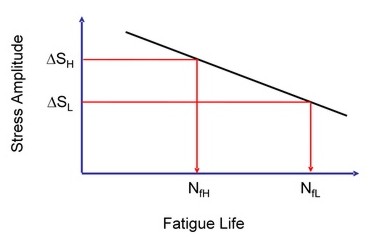
eFatigue gives you everything you need to perform state-of-the-art fatigue analysis over the web. Click here to learn more about eFatigue.
Damage Summation Technical Background
Once individual cycles have been identified by rainflow counting the fatigue damage for each cycle must be summed. Consider a simple loading sequence consisting of nH high amplitude cycles of ΔSH and nL low amplitude cycles of ΔSL. The corresponding fatigue lives for these two stress levels are denoted Nf H and Nf L.

A linear damage accumulation rule such as Miner's Rule simply states that if you use up half of the fatigue life at the one stress level you have half of the life remaining at any other stress level. This may be mathematically stated as

Fatigue damage for an individual cycle is the recriprical of the fatigue life, Nf. Fatigue lives for a cycle are computed using constant amplitude methods with the appropriate stress or strain ranges, mean stresses and material properties. Damage is then summed for all cycles in the loading history.

What should the value of damage at failure? If damage was truly a linear process the damage at failure would be equal to 1. Experiments on typical loading histories have shown that the value is usually between 0.3 and 1.0 depending on the type of loading history. In simple two step block loading, a sequence of high amplitude cycles followed by low amplitude cycles will have a damage sum D < 1.0. Similarly, a sequence of low amplitude cycles followed by high amplitude cycles will have a damage sum D > 1.0. Random loading histories have D ~ 1.0.